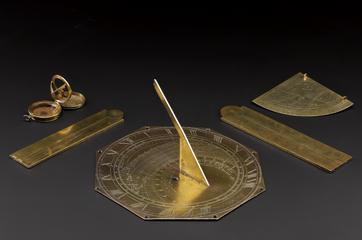






















AT-1 telescope owned by Oleg Ivanovsky, made in the Soviet Union (USSR), 1957-1958. This telescope was one of many distributed by the USSR during the International Geophysical Year (1957-1958). They were issued to colleges and universities and used by teachers and students as part of an international programme for tracking artificial satellites, known as sputniks. This Soviet programme mirrored the 'Moonwatch' satellite-tracking programme administered in the USA.
This AT-1 telescope was one of many as part of a large, organised citizen science programme to optically track the first artificial satellites. When the first such satellites were launched – beginning with Sputnik on 4 October 1957 – technologies for automatically tracking and photographing them were under active development. As a result, in the Soviet Union, USA and other nations across the world, professional scientists and engineers recruited amateur participants to collect data that directly contributed to the development of satellite tracking technologies.
There were 70 working teams of observers in the Soviet Union by 1958, each equipped with 30 AT-1 telescopes. Physics and mathematics departments at universities and colleges helped to coordinate the observers, who were usually students and sometimes teachers. The telescopes were designed so that observers could locate and log the passage of a satellite with adequate precision. The field was marked with a system of rings and crosses, and a button, when pressed, automatically sent a signal to a computing centre which logged the satellite’s position. An equivalent amateur programme, known as ‘Moonwatch’, was also coordinated in the USA by Fred Whipple, director of the Smithsonian Astrophysical Observatory. The value of this ‘mass data source [was] to help calibrate and hone those readings obtained from the “official” observations. Such data would be especially important when tracking any satellites with decaying orbits (the early ones were orbited at relatively low altitudes and quickly impeded by the Earth’s atmosphere) as they fell towards Earth’ (quote from Doug Millard’s 2016 book, Satellite). In the USA, Moonwatch echoed the earlier ‘Skywatch’ programme, in which citizens searched the skies for Soviet aircraft.
This particular telescope (No. 02408) is not only representative of this important international programme, but has additional significance as it was owned by Oleg Ivanovsky, Soviet rocket scientist and deputy chief engineer of the first and second Sputniks. Ivanovsky went on to become chief designer of OKB-1, the design bureau fronted earlier by Sergei Korolev.
Details
- Category:
- Astronomy
- Object Number:
- 2023-99
- Materials:
- metal (unknown), enamel and glass
- Measurements:
-
telescope: 405 mm 92 mm,
mount: 315 mm
- type:
- telescope
- credit:
- Bonhams




